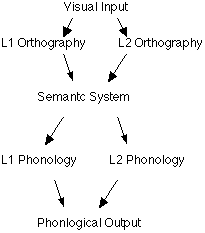
The Big Question:
How do these various networks (past tense, morphology, visual
recognition), combine to do multiple tasks? Why are there always so
many boxes? Couldn't one system perform the fuction of many boxes?
Indeed, Lashley was both right and wrong. The brain appears both
localized and yet distributed.
So for language, do we really need dual route
models of inflectional morphology and/or word recognition and naming?
Can connectionist models provide a methaphor for how a single system
could implement two different tasks?
Bilingual Word Recognition
Are two languages merely sub-division of the same system (much like the aphasic data for the seperation between nouns and verbs), or are they completely seperate language systems? In the standard view, bilingual is lexically specific and yet semantically homogenous. Evidence for this includes interlingual homographs (red in english and spanish). If read red (infrequent in spanish) very slow recognition, but if read red in English very fast, in accords with frequency.

Still, you get interference effects. So what's going on? Well,
tried an IAC model for language. And at the lexical level therewasn't
any distinctive difference between this and Thomas's BIN model both
of which showed that internal hidden units could exhibit both
independence and yet interference (just like the himan data). Of
course, in the model, interference effects are the result of
similiarity effects. Thus, the single route model would now seem
better.
However, dual route models incoporate
aspects of the single route model and thereby accounted for the data
as well. So how seperate? Interference effects, dissociations,
independent acquisition, and parallel access.
Independence effects
Surely, one must, for the dual route, demonstrate functional
independence. And yet, in the face of this, for bilingual naming,
people are effected by the pronuciation rules of both languages.
Still, the DR people say: "well the routes aren't properly
controlled." Pinker.
OK, well sounds like the same
predictions, so better implement a dual route cognitive model. Until
have quantitative predictions, can't seperate here.
Dissociations
Now the onous is on single route accounts to explain these. Still recent work shows that double dissociations are possible in connectionist networks as well. However, these dissociations are relatively rare. So, is this the case in the real world? Hmm.
Independent acquisition
Well, seems like the single route has a problem with catastrophic interference. Shouldn't learning in one language interfere with subsequent learning? Well, the C response is the CI does occur and there are ways to get around this (expansion encoding, for example).
Parallel Access
Ok, if really two routes, should be able to use both at once. Thus, priming effects should be see because of priming in the unused route. Therefore, the priming should be equal within and outside the language being trained. And Thomas never found evidence of this, thus the dual route mdel seems weak.
Conclusions
The single route shows some support, but acquisition is still an important question. However, the wider question revolves around the kinds oof representations involved.
|
Coments to: ghollich@yahoo.com |
Last Modified: Sep 20, 1999 |